
- Articles
A journey through time to ancient Greek medicine with medical historian and classical scholar Plinio Prioreschi, MD, PhD
In our review of the first volume in this series we introduced the medical scholar Dr. Plinio Prioreschi, the author of this marvelous narrative of the history of medicine, and listed the composition of this series of tomes for the benefit of the readers.[1] We do so again here for the same reason:
- A History of Medicine — Volume I: Primitive and Ancient Medicine (2nd edition, 1995); 596 pages
- A History of Medicine — Volume II: Greek Medicine (2nd edition, 1996); 771 pages
- A History of Medicine — Volume III: Roman Medicine (1st edition, 1998); 822 pages
- A History of Medicine — Volume IV: Byzantine and Islamic Medicine (2001); 498 pages
- A History of Medicine — Volume V: Medieval Medicine (2003); 804 pages
- A History of Medicine — Volume VI: Renaissance Medicine (2007); 801 pages
This second volume comprises the following subjects and chapter topics in ancient Greek medicine:

Chapter I: Historical outline and socioeconomic background sets the tone of the book and provides the necessary background material to understand Greek philosophy and medicine. Prioreschi also uses this introductory chapter to deal with the controversial subject of the perceived ubiquitousness of homosexuality in the Greek and Hellenistic world. In this context, the case of the celebrated treatise Against Timarchus by Aeschine, political and juridical opponent of Demosthenes, as well as the writings of Plato and Aristotle are discussed.[4]
In this review, we will restrict ourselves to reviewing the second tome in the series — Greek Medicine as it relates to medical history and ethics.[3] From the outset, let us state this volume is also magnificent and continues in the same tradition of Prioreschi’s excellent scholarship, orderly organization, and superb narration. As we will see, Prioreschi also does not hesitate to deviate from orthodox or dogmatic views when new facts have come to light or previous information has been neglected or misinterpreted, or when logical reasoning calls for a new interpretation of the facts.
Chapter II: Religion and philosophy in Greece; pre‑Socratic philosophers; Socrates (469–399 B.C.), Plato (427–347 B.C.) and Aristotle (384–322 B.C.); and the post‑Socratic and Hellenistic schools. The inclusion of this chapter underscores the ongoing influence of philosophy on ancient naturalistic Greek medicine.[5]
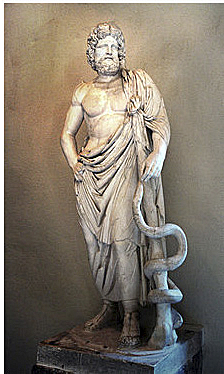
Chapter III: Science and technology. Although Prioreschi defines science in the stricter sense of knowledge acquired by the scientific method, the term is defined here in the broader sense as knowledge gained by the ancients via the naturalistic, nonscientific paradigm. In ancient Greece, as in the rest of the ancient world, supernaturalistic medicine continued to be practiced by the physician‑priests (followers of the god of medicine Aesculapius [photo, left) at the temples side by side naturalistic medicine practiced by Hippocratic physicians. But even Hippocratic physicians did not completely abandon supernaturalistic notions, such as the occasional invocation of the gods or assignation of astrological signs (e.g., celestial bodies influencing treatments and prognosis) and the use of numerology (i.e., assignation of “critical days”) in clinical practice, etc.[6]
Chapter IV: Greek medicine before Hippocrates (460–370 B.C.) was intricately entwined with the natural philosophy and was centered in Magna Graecia (Southern Italy and Sicily) and Ionia (Western coast of Asia Minor), circa 600–500 B.C. This included the famous School of Croton, which flourished c. 550 B.C. until it was destroyed by its neighboring town Sybarus in 510 B.C. Croton was the city‑state of Magna Graecia where Pythagoras (c. 582–c. 507 B.C.) settled after leaving Samos and continued to exert considerable influence. He propounded that the harmony of nature was found in numbers, and believed in reincarnation, transmigration and the immortality of the soul. The celebrated Greek physician Democedes and the influential Alcmaeon managed to separate medicine to some extent from philosophy (while still associated with the Pythagoreans), and were the leaders of the medical group in Croton. Democedes became physician to Polycrates, the tyrant of Samos, was captured by the Persians, and while in captivity successfully treated the Persian king, Darius I. He managed to escape Persia and return to Greece where he married the daughter of the famous Greek wrestler Milo.[7]
Empedocles (c. 493–433 B.C.) founded the Sicilian school and proposed the widely recognized and influential Four Element theory — i.e., the universe as composed of the primordial elements, fire, earth, water and air, which was accepted by Plato. Empedocles also posited cosmic cycles of the universe as a result of the opposite forces of love and strife. Miletus and Ephesus were the leading commercial and intellectual cities of Ionia. Heraclitus of Ephesus (c. 535–475 B.C.) proclaimed that all matter was in motion; that fire was the primordial element; and that change was eternal — thus the stated principle, “one cannot go into the same water twice”. Divinity is in nature but it follows natural laws. The Greek Ionian dialect became the literary as well as the medium for philosophy and the Corpus Hippocraticum. The physician Diogenes of Apollonia gave an interesting description of the vascular system suggesting that human dissection may have been performed before the Alexandrians. In physiology, he subscribed to the theory that universal substance of the body, the pneuma, was not only the vital force but also the soul of man. Prioreschi concludes that by the end of the 5th century two concepts had evolved: First, that the seat of intelligence was either in the heart or the brain, and second, that pneuma was identified as the vital force, if not the seat of the soul in both man and animal. Philosophy encouraged speculation; medicine, observation; but the two were entwined in medicine, which as in the case of Greek science had developed from philosophy.[7]
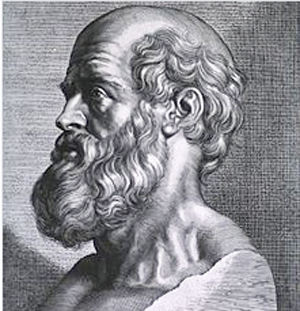
Chapter V: Hippocrates and Hippocratic medicine. Hippocrates (photo, left) remains a figure of heroic proportions even if “dimmed by the mist of time.” Hippocratic medicine refers to the body of writings and tenets contained in the Corpus Hippocraticum and the Anonymous Londinensis. The Schools of Cos (Coan) and Cnidus (Cnidian) are the two main sources of material for the Corpus Hippocraticum and consist of writings by physicians from approximately 450–350 B.C., physicians who uphold the medical principles of Hippocrates from those schools, and perhaps Croton and Sicily as well. The Corpus Hippocraticum consists of up to 98 separate texts, including the famous “Oath of Hippocrates (Orkos),” and such texts as “On Epidemics,” “On Decorum,” “On Humors,” “On Women’s Diseases,” “Aphorisms (of Hippocrates),” etc. The other source of Hippocratic medicine, the Anonymous Londinensis, is a compendium of medical texts now known to have been composed by Melo (or Melon), a student of Aristotle. It is so named because the invaluable papyrus scroll (Iatrike synagoge) was only discovered in the 19th century at the British Museum in London.[8]
Of superlative interest is the antecedent medical information gathered by Galen (A.D. 129–200), the other figure of heroic proportions in medical history (to be discussed in Prioreschi’s A History of Medicine, Volume III: Roman History) about the three schools of medicine in the 5th century B.C.: Cos, Cnidus, and Sicily. The Cnidian school apparently based its teachings of the etiology of diseases on the theory of perittoma (or perissoma), a concept eerily similar to the Egyptian formula for the pathophysiological basis of disease as previously discussed in our review of Prioreschi’s A History of Medicine, Volume I: Primitive and Ancient History.[1] The Cnidian school of Hippocratic physicians ascribed diseases to the perittoma, in the same fashion as Egyptian physicians attributed diseases and aging to whdw (ukhedu), the intestinal residue of undigested food, fecal and putrefied matter. The Coan School (from the island of Cos) in contrast subscribed to the humoral doctrine of disease in which an imbalance of the four humors — i.e., blood, phlegm, black bile, and yellow bile — cause disease. Illness could also result from corrupted bile and phlegm and putrefaction, but only as secondary factors to the primary humoral doctrine of the Coan school.
Although Prioreschi does not discuss this, I believe the origin of the humoral theory is based on two concepts. One has already been mentioned, and it is the theory of the Four Primordial Elements posited by the physician and natural philosopher Empedocles. The other concept arises, according to medical historian Dr. Félix Martí‑Ibáñez, from the observation of standing blood in a laboratory test tube, whereby the blood after a period of time spontaneously separates into four components of different colors at four distinct layers: Blood serum; blood; blood sediment; and the fibrin layer. According to Martí‑Ibáñez the term “white beast” came about in reference to the blood of pregnant women with a high sedimentation rate (same as with various illnesses), whereby fibrin accumulates at the top, rather than remaining normally in the bottom. Higher sedimentation rates denote more and more fibrin floating to the top. And so by tracing the layers of blood components and their shifts in position in the test tube, we have arrived to the four components of blood corresponding to the Hippocratic theory of the four humors. Their qualities were subjectively determined as were their sites of origin or organ predilection according to the Hippocratic humoral theory:
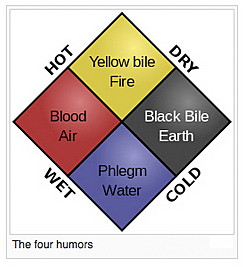
- The top serum layer: Yellow Bile; qualities, hot and dry; originating in the liver corresponding to the original element fire
- The middle layer (oxygenated blood cells): Blood; qualities, hot and wet; originating in the heart and corresponding with the element air
- The dark sediment layer (deoxygenated blood cells): Black bile; qualities, cold and dry; originating in the spleen and corresponding with the element earth
- The bottom fibrin layer: Phlegm (mucus); qualities, cold and wet; originating in the brain and corresponding with the essential element water.[2]
And depending on the predominant humor in the individual, a man’s temperament was choleric for yellow bile; sanguine for blood; melancholic for black bile; and phlegmatic for mucus (phlegm). With the advent of scientific medicine the humors have been discarded but the descriptive psychosocial traits are still in use today.
The primary doctrine in the Corpus Hippocraticum, as a whole, is the humoral doctrine, and it is only in the Anonymous Londinensis that the secondary doctrine of perittoma is actually named.[8] Another difference of opinion between the two schools of medicine refers to the primacy of the heart or brain in perception, thoughts, and emotions. The Cnidian/Sicilian schools generally gave priority to the heart; the Coans, to the brain.
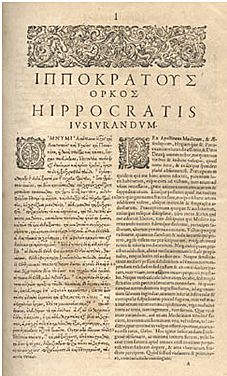
It is in this section that one of the most interesting discussions takes place in the history of medical ethics. The medical historian Ludwig Edelstein had in various articles, most notably in the Bulletin of the History of Medicine (1943), argued that the Oath of Hippocrates was a Pythagorean document followed by a very small number of Greek physicians with little influence in the classical world. Edelstein managed to convince such authorities as Henry E. Sigerist, who published a book on medical history in 1961 supporting many of Edelstein’s points. These references are included in Dr. Prioreschi’s book.[8] One by one, Prioreschi effectively rebutted Edelstein’s assertions with solid documentation and argument, making this tome a landmark treatise not only in medical history but also in the history and application of medical ethics in the world today. Edelstein’s assertions have gone uncorrected for more than half a century. As a medical student, I remember scratching my head and pondering Edelstein’s assertions. For example, Edelstein asserted that the Oath of Hippocrates (photo, left) did not represent the accepted ethical practices of Greek physicians and that it proscribed the practice of surgery. According to Edelstein, most physicians either were not aware of the Oath or ignored it, claiming that Greek physicians practiced surgery, assisted suicide, performed abortions or provided abortifacients to their patients, and we may presume they also caused mayhem in patients’ families with sexual indiscretions and divulging confidential information! As a student of medicine, and later as a neurosurgical resident, I wondered how ancient Greek physicians then managed to thrive and maintain the confidence of patients with such horrific “bedside manners” and unethical practices in conjunction with the dismal cure rates obtained in prescientific medicine! Although I read opinions for and against Edelstein’s thesis, the matter remained unresolved and somewhat murky until the advent of this volume which, in my opinion, settles the matter and places the origin of the Oath and ethics of Hippocrates back on a clear and more solid foundation.[9]
Prioreschi summed up the situation as follows: “The Oath was what it had traditionally been considered to be before Edelstein’s work, namely a code of conduct for physicians that reflected commonly accepted ethical practices; that its Pythagorean traits are coincidental; and that the numerous [purported] violations of it by ancient physicians were not related to its alleged Pythagorean origin.”[9] In other words, we have no evidence to doubt that most ancient Greek physicians followed the teaching of the Corpus Hippocraticum. Hippocratic physicians did “not cut the stone” because that was a serious operation with a grave prognosis, and therefore such specialized high‑risk procedures were left to itinerant specialists; they performed surgery; for the most part they practiced good bedside manners and abstained from having sex with their patients; they did not divulge privileged information; they did not perform abortions; they did not give poisons to their patients, etc., as commanded by the ethics outlined by Hippocrates. In fact, as we will see in our review of Volume III: Roman Medicine, the Roman physician Scribonius Largus, who practiced medicine in the 1st century A.D. and who was physician to Emperor Claudius (ruled AD 41–58), referred to the Oath of Hippocrates in his Preface to his Compositiones Medicamentorum and summarized thereby in a famous narrative what was accepted (and expected) compassionate professional ethical practice by the physicians of his time. This Preface is translated and quoted in full by Prioreschi.[15] Thus, the Oath of Hippocrates may not be recited today in medical schools because of political correctness and the zeitgeist of the times — but not because it is irrelevant or because recently uncovered historic scholarship supports discontinuation of its recitation![14]
This chapter also goes into significant detail about Hippocratic symptoms of diseases, clinical signs, physical diagnosis, pharmacopeia, therapeutics, and surgery. The fallacious (but well‑known) concept of the benignity of suppuration, as being a sign of wound healing — i.e., pus bonum et laudabile (“laudable pus”) — was upheld by Greek physicians. The concept, which survived into the 19th century, may have arisen due to the fact circumscribed suppurative staphylococcal infections may have had a better prognosis than disseminated streptococcus infections.[9]
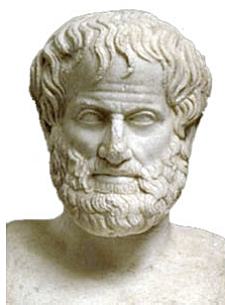
Chapter VI: Transitional chapter from Hippocratic medicine to the Alexandrian (Hellenistic) medicine. This chapter expounds on the medical insights and theories of Plato and Aristotle (photo, left), the latter contributing also to biology, anatomy, physiology as well as medicine. Aristotle affirmed the importance of the naturalistic paradigm that observation is important and credence must be given to evidence procured by the senses more than to theories. And theories must agree with what is observed (data), effectively a dictum of modern science. Aristotle also urged the teleological principle stipulating that nature always accomplishes the best result for a specific purpose. Plato subscribed to the four elements and posited the principle of necessity; for Aristotle it was purpose (final cause). Aristotle’s minutely observant and eloquent description of a chick embryo is a classical masterpiece quoted in full by Prioreschi.[10] The scholarship of Aristotle was continued by Theophrastus (372–286 B.C.), his pupil at the Lyceum who headed the Peripathetic school after Aristotle’s death. In his own right Theophrastus wrote a treatise on sensation and propounded the Doctrine of Signatures that applied botany to pharmacopeia and therapeutics — i.e., the similarity of the form of a plant purportedly mimicked its pharmacologic effect (i.e., “like imitates like”), a concept that lasted until the Middle Ages. Strato of Lampsacus (c. 330–268 B.C.) followed Theophrastus at the Lyceum, the last head of the school physicos (philosopher‑physicist) to do original work. It was Strato who explained the concept of horror vacui, “horror of the void,” a principle better known today as “nature abhors a vacuum.” Strato gave an elegant physical explanation of this phenomenon that Prioreschi also quoted in full “as a stunning example of scientific reasoning.” Unfortunately, the concept itself was used erroneously to perpetuate the fallacy that arteries carried pneuma, rather than blood. Bleeding from an artery, therefore, was explained by the great Erasistratus (fl. 3rd century B.C), the Alexandrian anatomist and physician, as the result of instantaneous horror vacui with blood rapidly filling the arterial void and then bleeding into the wound![10]
Chapter VII: Alexandrian medicine. This chapter relates the advances in science and medicine achieved at and promulgated from Alexandria, the intellectual capital of the Hellenistic world ushered in by Alexander the Great’s conquest of Egypt and the Middle East. Alexandria had become known for the cultivation of the arts and sciences, the reputation for learning and the acquisition of books by its Library and Museum, policies begun by Ptolemy I and continued by his successors. The two great figures in medicine and surgery at this time in the Museum of Alexandria were Herophilus and Erasistratus, who were contemporaries in the mid‑3rd century B.C. Herophilus and Erasistratus performed surgery and human dissection and conducted anatomical studies that could have revolutionized medicine. Prioreschi discusses why this did not take place. The fact is the rest of the medical community and the scientific world were not yet ready.[11,13]
Hellenistic medicine in the 3rd century B.C. split into two major schools: the Dogmatists, who followed the teachings and practice of medicine according to the tenets of Hippocratic medicine and continued to uphold theoretical principles; and the Empiricists, who were influenced by the skeptic philosophers, believed that experience was all that was necessary to practice medicine, and rejected book learning and anatomical studies.[11]
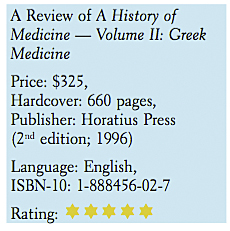
Chapter VIII and Conclusion: Prioreschi ends his magnum opus with a chapter on Greek physicians, discusses their social standing, and notes inscriptions dedicated to them, etc.[12] Prioreschi continues with explanations as to why the almost universal dictum that hopeless cases should not be treated was followed so commonly throughout the ancient world. He then makes concluding remarks as to why the major similarities existed in the medical systems of antiquity — the answer of course was the concept of limited options discussed previously.[1,13] This tome is a worthy sequel to Prioreschi’s first volume, Primitive and Ancient Medicine, and it is also highly recommended for both its invaluable information on medical history as well as the corrections and clarifications of the tenets of the Oath and ethics of Hippocrates. This tome, A History of Medicine — Volume II: Greek Medicine by Dr. Plinio Prioreschi, belongs in every public library and in the book repertoire of every physician, medical historian, bioethicist, and student of medical ethics.
REFERENCES
1. Faria MA. A fascinating look at Primitive and Ancient Medicine by the medical and classical scholar Plinio Prioreschi, M.D. A review of Prioreschi P. A History of Medicine — Volume I: Primitive and Ancient Medicine. Omaha, Nebraska: Horatius Press; 1995. Surg Neurol Int 2015;6:87. Available from: [Last accessed on 2015 June 9].
2. Martí‑Ibáñez F. A prelude to Medical History. New York: MD Publications Inc.; 1961. p. 88‑90.
3. Prioreschi P. A History of Medicine: Vol. II: Greek Medicine. Omaha, Nebraska: Horatius Press; 1996.
4. Prioreschi P. A History of Medicine: Vol. II: Greek Medicine. Omaha, Nebraska: Horatius Press; 1996. p. 7‑57.
5. Prioreschi P. A History of Medicine: Vol. II: Greek Medicine. Omaha, Nebraska: Horatius Press; 1996. p. 58‑130.
6. Prioreschi P. A History of Medicine: Vol. II: Greek Medicine. Omaha, Nebraska: Horatius Press; 1996. p. 131‑62.
7. Prioreschi P. A History of Medicine: Vol. II: Greek Medicine. Omaha, Nebraska: Horatius Press; 1996. p. 163‑206.
8. Prioreschi P. A History of Medicine: Vol. II: Greek Medicine. Omaha, Nebraska: Horatius Press; 1996. p. 207‑400.
9. Prioreschi P. A History of Medicine: Vol. II: Greek Medicine. Omaha, Nebraska: Horatius Press; 1996. p. 358‑99.
10. Prioreschi P. A History of Medicine: Vol. II: Greek Medicine. Omaha, Nebraska: Horatius Press; 1996. p. 401‑72.
11. Prioreschi P. A History of Medicine: Vol. II: Greek Medicine. Omaha, Nebraska: Horatius Press; 1996. p. 473‑563.
12. Prioreschi P. A History of Medicine: Vol. II: Greek Medicine. Omaha, Nebraska: Horatius Press; 1996. p. 565‑86.
13. Prioreschi P. A History of Medicine: Vol. II: Greek Medicine. Omaha, Nebraska: Horatius Press; 1996. p. 587‑635.
14. Prioreschi P. A History of Medicine: Vol. III: Roman Medicine. Omaha, Nebraska: Horatius Press; 1998. p. xix-xxxvi.
15. Prioreschi P. A History of Medicine: Vol. III: Roman Medicine. Omaha, Nebraska: Horatius Press; 1998. p. 177‑79.
Article written by: Dr. Miguel Faria
Miguel A. Faria, Jr., M.D. is Clinical Professor of Surgery (Neurosurgery, ret.) and Adjunct Professor of Medical History (ret.) Mercer University School of Medicine. He is an Associate Editor in Chief and a World Affairs Editor of Surgical Neurology International (SNI), and an Ex-member of the Injury Research Grant Review Committee of the Centers for Disease Control and Prevention (CDC). 2002-05; Former Editor-in-Chief of the Medical Sentinel (1996-2002), Editor Emeritus, the Association of American Physicians and Surgeons (AAPS); Author, Vandals at the Gates of Medicine (1995); Medical Warrior: Fighting Corporate Socialized Medicine (1997); and Cuba in Revolution: Escape From a Lost Paradise (2002).
This article was originally published in Surg Neurol Int 2015;6:100. This article can be cited as: Faria MA. A journey through time to ancient Greek medicine with medical historian and classical scholar Plinio Prioreschi, MD, PhD. Surg Neurol Int 2015;6:100. Available from: http://surgicalneurologyint.com/surgicalint_articles/a-journey-through-time-to-ancient-greek-medicine-with-medical-historian-and-classical-scholar-plinio-prioreschi-md-phd/
The photographs used to illustrate this book review came from a variety of sources and do not appear necessarily in the author’s book. They were used to illustrate this article for the enjoyment of our readers here at HaciendaPublishing.com.
Copyright ©2015 Miguel A. Faria, Jr., MD